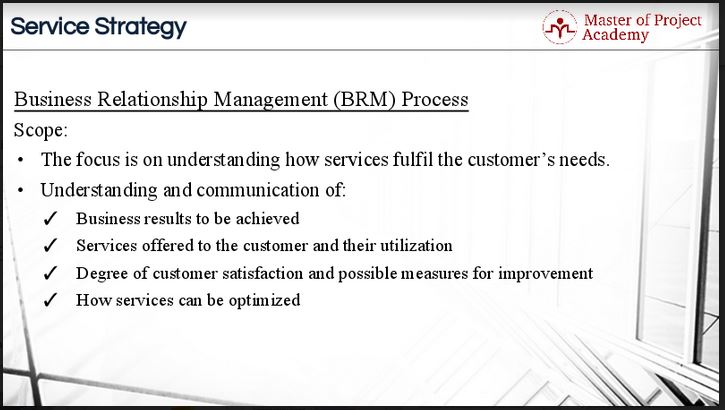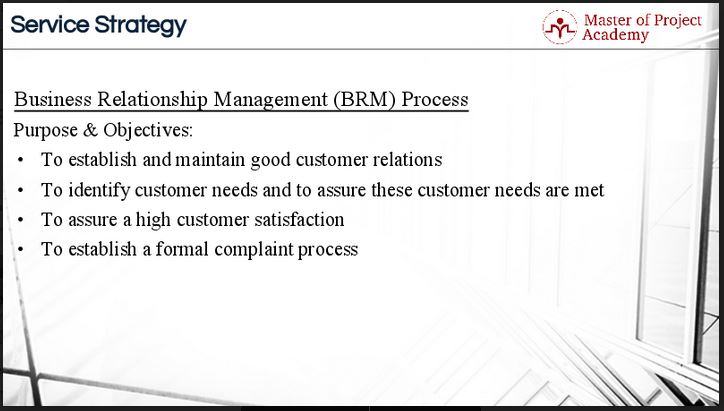ITIL business relationship management is the last process of the Service Strategy stage of the ITIL lifecycle for services as discussed in ITIL foundation certification training. The main scope of the ITIL business relationship management process within the ITIL Service Strategy stage is understanding how services fulfill the customer’s needs.
A service provider provides services for the use of its customers. And for a strong ITIL business relationship management, these services need to match the customer expectations. Otherwise, customers will not use these services and the service provider will not be able to generate revenue from its services. In the long-term, this will not be a sustainable business for the service provider. The role of ITIL service management process for sustainable business is explained in ITIL online courses. Therefore, during the definition of the market step of ITIL Service Strategy stage, the market is assessed, gaps in the market are analyzed and services which most of the customers will use are aimed to be designed. And ITIL business relationship management process helps to identify how services meet the customer’s needs.
The scope of ITIL business relationship management
ITIL Business relationship management processes have been developed to understand and communicate several factors during the Service Strategy Stage of the development of a new or existing IT service. Without taking these factors into account, a successful IT service that delivers value to the customers and revenue to the business will not be developed. The following four factors are in scope of the ITIL business relationship management process:

It understands the business results to be achieved
For instance, what is the expectation of a customer from a money withdrawal process? What is the expectation of a customer from a call to the call center? The answers to these questions might be: completing money withdrawal in less than thirty seconds or finding an answer to a question in less than forty-five seconds after calling the call center. These are examples of business results to be achieved that needs to be clarified in the Service Strategy stage of the ITIL lifecycle for a great ITIL business relationship management.
It studies services offered to the customer and their utilization
Service providers offer hundreds, thousands of services for the use of its customers. But only a minority of these services are highly demanded by the customers. Therefore, ITIL business relationship management clarifies services offered to the customer and their utilization as well. During the Service Strategy stage of the ITIL service lifecycle, this information is used to decide which services would be the best to develop from an IT strategy point of view. Understanding how existing services are used, organizations can get a better understanding of which services are working, which are not and which are needed by the customers.
It studies the degree of customer satisfaction
ITIL Business Relationship Management covers the measurement of customer satisfaction. Although the services operate without any technical problems, customers might not be satisfied with the services. For instance, a competitor might provide faster services, or the same services at a lower cost. Therefore, ITIL business relationship management monitors and observes customer satisfaction and analyzes the points and factors affecting customer dissatisfaction.
It studis the optimization of the services
ITIL Business relationship management understands and communicates any needs for optimization of current services. During the Service Strategy stage, new services and existing services that need improvement are aligned with the business strategy. With ITIL business relationship management, the service management team determines how existing services can be optimized for better efficiency and effectiveness. This is important information for the next stage of the ITIL service lifecycle: ITIL Service Design.
The purpose and objectives of ITIL business relationship management

ITIL business relationship management objective: establishment and maintaining good customer relations
Customers are the main source of revenue for a service provider and satisfied customers generate more revenue. Therefore, the ITIL business relationship management process mainly aims to establish and maintain good customer relations to increase customer satisfaction and improve the profitability of the organization.
ITIL business relationship management objective: identifying and meeting customer needs
Only customers whose needs or expectations are met can be satisfied by a service provider. Therefore, before planning, designing and implementing a service can be done, the market analysis must be conducted. What are the different customer segments? What are their needs and expectations? The answers to these questions should be clarified to deliver services that will fulfill the customer needs. Otherwise, customers who cannot satisfy their requirements with a service provider will try to find other alternatives in competitors and whenever they find a better service, sooner or later, they will switch to the competitors.
Furthermore, ITIL business relationship management does not only aims to meet the customer requirements. It aims to meet and exceed the customer expectations. This is because high customer satisfaction comes only if the customer receives more than he or she expected from a service.

ITIL business relationship management objective: establish a formal complaint process
In the case of a problem or query, customers need to be able to reach a service provider organization either through regular mail, service desk, call or via web services. And the problems of the customers need to be solved in order to increase customer satisfaction. It is important to include the formal complaint process in any continual service improvement programs as customers who are happy with the service, in general, may become dissatisfied if the customer complaint process is not 100% customer orientated. The system must be easy and fast to use and human operators must be friendly and helpful. Customers must be helped in as little time as possible. In addition, the problems that are reported through this formal complaint process must be immediately addressed by the service management team to ensure that no customers are lost due to bad service provision.
ITIL Business relationship management is an important step in the Service Strategy Stage of the ITIL service lifecycle. In this process, the customers’ needs are brought to the table and the service management team can compare the customers’ needs to their IT service strategy to see if these are aligned. While services must be aligned with business strategies, they must also be aligned with customers’ unmet needs and this is achieved with business process management. New services that directly addresses a need of customers will draw attention and will be used frequently by new and existing customers.

